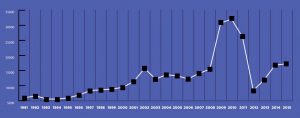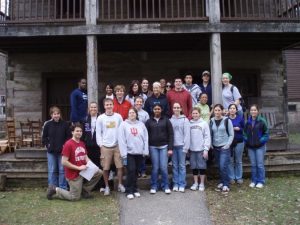By: Arianna Koppen, Bicentennial Intern, Class of 2018, Tourism, Hospitality, and Event Management, and Public, Nonprofit, and Community Recreation, Bloomington
“No child who is willing to work hard, sacrifice, and make the grade should be denied the dream of a college education” – Governor Evan Bayh, 1990 [1]
Before I began my internship with the Office of the Bicentennial, I took some time to think about the various identities I hold on campus. As a 21st Century Scholar, I decided I had a great opportunity to learn more about the program that, for me, turned college from a possibility to a reality. I found the research process enlightening, as I began making connections between my previous basic knowledge of the program, how it fits into an overall political context, and my personal experiences.
Aside from online research, I interviewed key people on campus and spent a few days in the IU Archives. The archives require patience and a strategic approach. I originally thought it would be a good idea to request all 75 boxes from one collection, but decided to start with the 10 that seemed the most relevant. When I walked into the archives and saw these few boxes laid out, I was beyond overwhelmed.
A large portion of the documents I looked through were not related to my project, but many times, I found key information or clues that led my research in other directions.
21st Century Scholars Background
Years before I was born, when Evan Bayh began his tenure as Indiana governor in 1989, one of his top priorities was to make higher education accessible for anyone who deserved it. Governor Bayh was inspired by businessman and philanthropist Eugene Lang, who somewhat impulsively promised a class of sixth graders that if they put in the work, he would pay for each of them to go to college.
After being drafted by State Representative Stan Jones, the 21st Century Scholars Program was signed into state legislation by the 1990 Indiana General Assembly. The 30th anniversary of the program will be in 2020, aligning with IU’s Bicentennial.

The first Scholars began enrolling in college in 1995 and graduating in 1999. As of 2015, more than 70,000 students statewide obtained their degree through the program. Of these students, more than 20,000 Scholars have attended IU, and 3,200 are currently enrolled at IU.
Statewide enrollment rates spiked in 2009 and 2010. This was during the national recession which lowered many families’ incomes. I found this especially interesting, since I applied as an eighth grader during the 2009-2010 school year.
The opportunity to apply to the program in middle school, as opposed to high school senior year, provides reassurance to kids who might have otherwise been hopeless about attending college.
21st Century Scholars on Campus
In 2003, the programming on campus expanded under Jeanetta Nelms’ leadership. For the first time, Scholars could go to the office in Ashton for help that was especially designed for them.
Effective at the start of 2007, the Lumina Foundation provided a three-year grant to implement a “Toolkit for Success” to promote retention and performance, supplementing existing services and creating new ones.
Some of these initiatives included one-on-one academic tutoring, campus cultural experiences, financial management workshops, and special minority male initiatives. Even after this grant ended, most of these programs are still offered today.

Around 2008, the ScholarCorps program was created, now known on campus as Volunteer Corps. Volunteer opportunities were organized, such as making baskets for Middle Way House and cleaning Spring Mill State Park.
Indiana University has been an inspiration for the way the program has developed on other Indiana colleges and universities. In 2007, IU created the 21st Century Scholars Covenant to supplement the existing program to cover unmet needs for additional expenses for 275 students in the first year. After the Covenant was created, the number of Scholars attending IU approximately doubled.

Currently, nearly 1 out of 5 in-state undergraduate students at IU are 21st Century Scholars.
Today, the 21st Century Scholars Program is housed in the Office of the Vice President for Diversity, Equity, and Multicultural Affairs, established in 1998.
Challenges
The program is one of Indiana’s initiatives to improve education, increasing college enrollment rates considerably. Indiana’s rate of high school graduates continuing to college in 1986 was 40th in the nation, and rose to 9th in 2002.[2] As well,
in 2005, 85% of 21st Century Scholars enrolled in college, compared with 56% of non-Scholars.[3]
Indiana’s program was the first of its kind and is often used as a model for other states to create similar programs. Several states, such as Oklahoma and Rhode Island, have created programs to cover some or all of tuition expenses with a range of eligibility requirements.
Despite its strong points, the 21st Century Scholars Program does not remove all barriers, including financial, psychological, and institutional obstacles that low-income students face before college graduation.
As well, Scholars at IU are 1.4 times more likely to be the first in their family to go to college and 2.5 times more likely to be raised by single parents.
Creating these programs to increase college accessibility is an important method of promoting higher education and combating the cycle of poverty. By offering a guarantee for college affordability, students will increase their aspirations and find pathways for future success.

References:
[1] Indiana State of the State Address, Indianapolis, IN, January 12, 1990
[2] St. John, E., Gross, J., Musoba, G., and Chung, A., “A Step Toward College Success: Assessing Attainment among Indiana’s Twenty-first Century Scholars”, Lumina Foundation for Education, 2005.
[2] Blanco, C., “Early Commitment Financial Aid Programs: Promises, Practices, and Policies”, Western Interstate Commission for Higher Education, August 2005, p. 24.